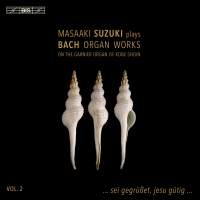Texte paru dans: / Appeared in: |
|
|
Outil de traduction ~ (Très approximatif) |
|
|
Reviewer: James
A. Altena This is the second release in Masaaki Suzuki’s planned cycle of the complete organ works of Bach, following his landmark set of the complete cantatas with his Bach Collegium Japan. Jerry Dubins favorably reviewed the preceding volume in 39:5, and I can only envy him that privilege, for this clearly is going to be a cycle to rank with the very best (Ton Koopman being my personal favorite). BWV 541 practically dances off the printed page with jubilant energy, with reed stops employed effectively to contrast the fugue from the prelude. The two concertos after Vivaldi, BWV 594 and 596, alternately bubble with high spirits and relax in restful reverie. The two chorale preludes on Liebster Jesu, Wir sind hier (Dearest Jesus, we are here), both cradled in flute stops, are islands of contemplative repose. The multi-part Chorale Partita on Sei gegrüßet, Jesu gütig oder O Jesus, du edle Gabe (Be thou greeted, kind Jesus or O Jesus, thou noble gift) gives Suzuki manifold opportunities to explore the full coloristic range of stops and registers on his instrument with imagination and verve. Only the closing Prelude and Fugue, BWV 547, mildly disappoints; the Prelude is done to a tee as a stately minuet, but the following Fugue is taken at too slow a tempo. On his previous disc Suzuki performed on the Schnitger/Hinz organ in the Martinikerk in Groningen in the Netherlands. Dubins applauded the instrument but thought that the recording ambience was too reverberant. Here, Suzuki plays on the organ of the Shoin Women’s University Chapel in the city of Kobe in Japan, an instrument built by Marc Garnier between 1981 and 1983. This has exceptional symbolic importance for Suzuki, as he was born in Kobe and began his work with the Bach Collegium Japan at this location. It is a fairly modest instrument in size, and in particular has a small pedal section. However, Suzuki makes extremely savvy use of his resources, and the pieces he has chosen minimize reliance on the less well-endowed aspects of the instrument. I for one do not feel that anything is lacking, and indeed enjoy the almost chamber-music-like clarity and intimacy of the results. The recorded sound is unusually crisp and clear; detailed booklet notes come in English, German, and Japanese. Here’s hoping that the entire rest of the series makes its way to me as well—and also that Suzuki, an accomplished harpsichordist as well as organist and conductor, also lives long enough in good health to undertake a complete survey of all the keyboard works. Strongly and enthusiastically recommended. | |
|
Support us financially by purchasing this disc from eiher one of these suppliers. Un achat via l'un ou l'autre des fournisseurs proposés contribue à défrayer les coûts d'exploitation de ce site. |
|
|
|
|
|
Cliquez l'un ou l'autre
bouton pour découvrir bien d'autres critiques de CD |
|




